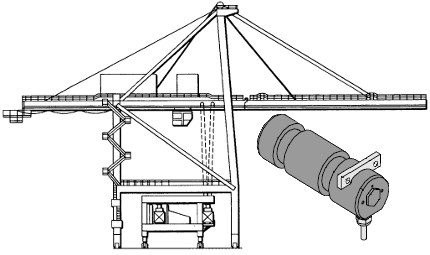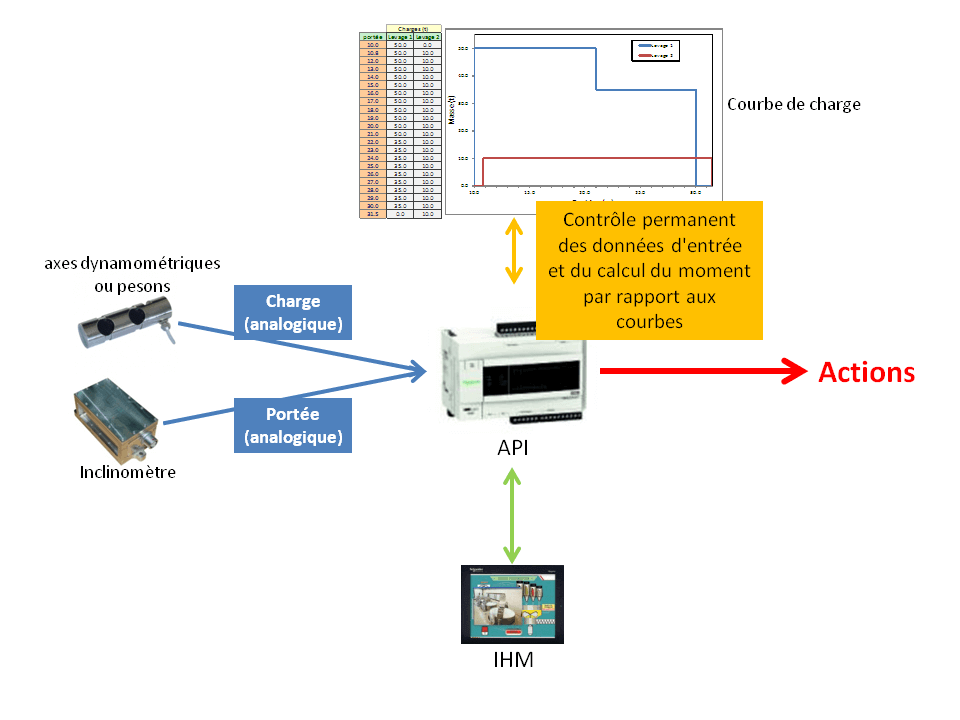Specific product: CEC
Load State Control

The regulations concerning the use of hoisting equipments require the presence of a CEC (Load State Control) system in order to prevent the risk of overload and tipping. Regulatory controls must be annually performed to verify the proper functioning of the system.
The purpose of the CEC is to avert and prevent the use of the crane beyond its capabilities: loads and ranges. The AES CEC is a system that installs on a new crane or is added in a box on a crane already in service. In the latter case, it could replace the existing obsolescent CEC systems.
Principe
Weighing sensors (load cells) allow the continuous measurement of the gross load. The analog signals from the load cells are integrated in order to obtain exploitable values. Any offsets are corrected and the signals are bounded in 4-20mA in order to be able to discriminate a malfunction of the sensors themselves. These signals are then used for:
- calculate their sum in order to deduce the total load under cables, so as to be able to deal with the absolute overload,
- analyze the load difference between the winches (for a container crane), to detect a differential overload between the 4 cables due to an eccentric load.
Depending on the load information, the PLC establishes the speed law for the movements and ensures compliance with this law.
- In the case of a crane: a position encoder or an inclinometer indicates the inclination of the boom, allowing evaluation of the range value. This value makes it possible to calculate the moment of the crane and to limit its operation beyond the authorized moment.
- In the case of a container crane: after locking the spreader on the container, the hoisting starts at a low speed to allow the CEC to detect any overload before starting the acceleration. It limits the dynamic effects on the hoisting ropes.
By these devices, the controller is able to continuously monitor the state of load of the crane and ensure its safety.

The core of the AES CEC system is a SIL3 Safety PLC and a Schneider Electric 5.7-inch Color Display.
According to the crane, the curve is adapted to the hoisting mode: hook, spreader, aerial platform, bull, etc. The load management ensures the safety which is necessary for the operation of the hoisting equipment in compliance with its nominal characteristics.
Adaptation to crane
The system can parameterize with any type of hoisting equipment (cranes, STS cranes, ship loaders, etc.), equipped with hook, bucket, spreader, or other system. AES studies, installs, parameterizes, and commissions the CEC. The service may include:
- Functional Analysis & Studies - Adaptation,
- Commissioning & reception,
- Training & documentation.
Summary
AES CEC (State Load Control) ensures a permanent check of the load and range during the operation of a hoisting equipment according to its nominal characteristics. It consists of a SIL3 safety PLC, load sensors, an inclinometer and a control screen. The function of the AES CEC bases on a permanent comparison of the signals from the sensors with the referential curves. According on these values, it can generate: a slowdown when an operating limit is approached, a stop when the limit is exceeded, or a limitation of certain parameters such as speed.
Do not hesitate to contact us further information about our products.



